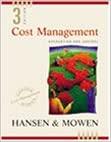Lancaster Company manufactures two types of hair conditioners, Creemy and Shiney, out of a joint process. The
Question:
Lancaster Company manufactures two types of hair conditioners, Creemy and Shiney, out of a joint process. The joint (common) costs incurred are $840,000 for a standard production run that generates 360,000 gallons of Creemy and 240,000 gallons of Shiney. Additional pro¬
cessing costs beyond the split-off point are $2.80 per gallon for Creemy and $1.80 per gal¬
lon for Shiney. Creemy sells for $4.80 per gallon, while Shiney sells for $7.80 per gallon.
Comida Buena, a supermarket chain, has asked Lancaster to supply it with 480,000 gal¬
lons of Shiney at a price of $7.30 per gallon. Comida Buena plans to have the conditioner bottled in 16-ounce bottles with its own Comida Buena label.
If Lancaster accepts the order, it will save $0.10 per gallon in packaging of Shiney. There is sufficient excess capacity for the order. However, the market for Creemy is saturated, and any additional sales of Creemy would take place at a price of $3.20 per gallon. Assume that there are no significant nonunit-Ievel activity costs.
Required:
1. What is the profit normally earned on one production run of Creemy and Shiney?
2. Should Lancaster accept the special order? Explain.
Step by Step Answer:

Cost Management Accounting And Control
ISBN: 9780324002324
3rd Edition
Authors: Don R. Hansen, Maryanne M. Mowen





